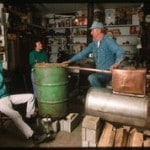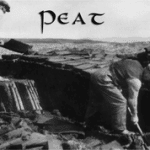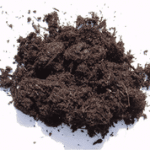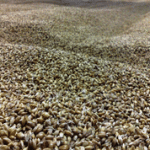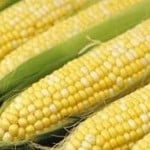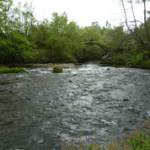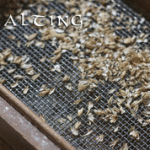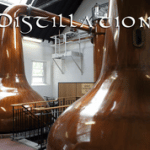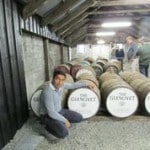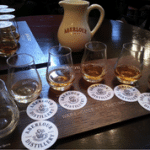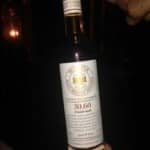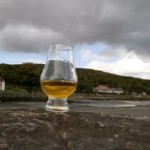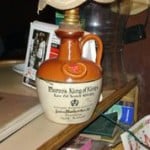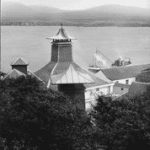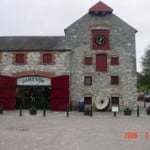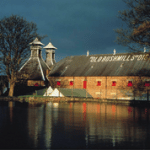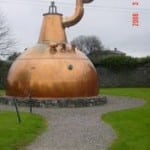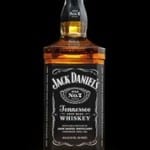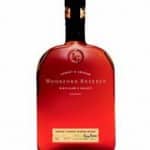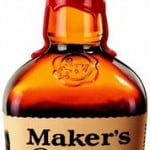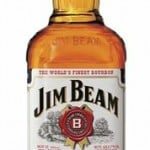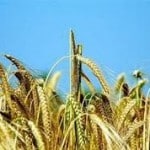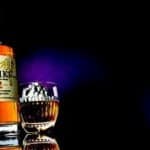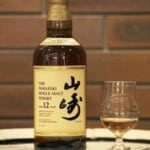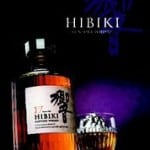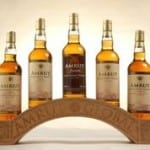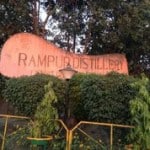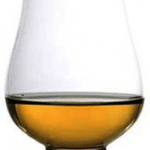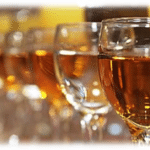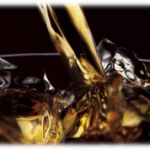Whiskey
- History
- Ingredients
- Making Whisky
- Types
- The Right Glass
- Cocktails
- GUEST COLUMN
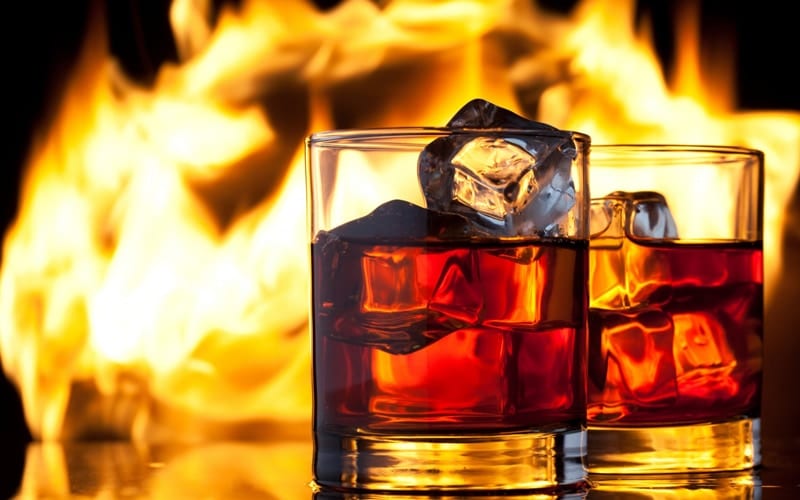
History
While the first confirmed written records of whisky come from Ireland in the early 15th Century the Scottish only got to this art later in the 15th century. But it was the Greeks who first invented the science of distillation which was used for medicinal purposes for centuries before it was used in making a distilled alcoholic beverage called “uisge beatha (ooshka-baha), a Scottish Gaelic term meaning Water of Life. Unlike today whisky was not allowed to age or be diluted and as a result tasted very raw and brutal compared to today’s versions.
The first written record of Scottish whisky can be found on some parchment made from calfskin that forms a 1491 Exchequer Roll. From the famous phase, “Friar John Cor of Lindores Abbey being granted ‘eight bolls of malt wherewith to make acqua vitae’ by King James IV”, we can see that monks at abbeys were granted the King’s commission to distill “acqua vitae” (whisky).
In the early 18th century England and Scotland merged together and in 1725 introduced a heavy Malt Tax on whisky production. This led to whisky production going underground to avoid the excisemen. The small time Scottish distillers took to distillation in the night time so that the smoke was not visible, this gave the drink its popular name Moonshine. It is estimated that during this period half of Scotland’s whisky production was illegal.
In the following pages we have talked briefly about the vast world of whiskies touching upon the various styles of whiskies, what goes into making a good whisky or whiskey and what are the brands to look out for.
So, let’s start by what is Whisky or Whiskey?
Whisk(e)y is a type of liquor distilled from a fermented mash of grains, usually rye, barley, oats, wheat, or corn, and matured in wood casks. Inferior grades are made from potatoes, beets, or other roots. Depending on where this beverage is being produced determines the fate of how it is spelled. In countries like Scotland, Canada, Japan or India it is spelled as Whisky whereas in Ireland and USA it is written as Whiskey and like everything else under the sun there are a few exceptions to this law as well.
Key Ingredients
The main ingredients for Scotch & mostly all whiskies is /are similar and are:
BARLEY (OR some other GRAIN): Barley or any other form of grain is at the core of the whisky production. The majority of distilleries buy in their malted barley from the large scale industrial maltings. These operate more quickly and efficiently than floor maltings, and the distiller can specify precisely the specifications of the malt required, all the way down to the exact degree to which it tastes of peat.
The quality of the barley has a great influence on the quality of the end product. The barley being used for the production of whisky is carefully selected. It is after all the basic ingredient which will determine the quality of the whisky which will be sold years later.There is no legal obligation to use Scottish barley to produce Scotch whisky. The most important thing is the highest sugar content and the lowest price. The combination of those two elements is often the only criteria in the choice of a variety of barley. A great deal of the barley used to produce Scotch whisky comes from England or South Africa.
While Barley is the key grain in case of Scotch whiskies, grains such as Corn or Maize, Rye, Wheat and Millet are also used in the production of whiskies. Corn is the major grain in case of American whiskies while Rye is popular in Canada.
WATER: The Gaelic “usquebaugh”, meaning “Water of Life”, phonetically became “usky” and then “whisky” in English. That’s how important Water is in the production of whisky. The quality of the whisky depends on the quality and purity of the water. The difference in taste between the whiskies coming from various distilleries is partly due to the quality of water used. Water in the Highlands is often peaty, which gives it a brownish colour.
YEAST: It is a microorganism which is a part of the Fungi kingdom. There are around 1500 styles and hundreds of uses of yeast. In the production of alcohol yeast plays the role of a catalyst and is responsible for kicking off a chemical reaction in the presence of sugar, water and oxygen.
Whisky Making Process
Please note that the process for making whisky or whiskey in principal is the same whether you look at it Generically or Geographically. Having said that all types of whiskies will have something about them which will enable that whisky or whiskey to be called or categorised as we know it. We will discuss that as we move along from Scotland to Ireland, America, Canada and India.
Malting
- Malt is the result of the malting process. The barley is wettened and spread on the malting floor to allow the germination process to start.
- A succession of chemical reactions change the starch contained in the barley to sugar.
- The malting art consists of finding the right moment to stop the germination process: not too late but not too early. According to the season, malting takes between 8 and 21 days.
- The end of the germination is triggered by drying the germinating barley over a fire (kiln). This oven is often heated by peat.
- Malting happens mainly at specialized plants, called maltings.

Grinding
This is the next step. When the malt is dry, it is ground to make a kind of coarse flour which will be used in the next operation.
- This flour is called GRIST
- Malt grinding is done with a malt mill in the distillery itself.
Mashing
The process of mixing the GRIST with WATER
- The grist is mixed with hot water in a mash tun.
- The MASH TUN’s were originally made of wood. Now more efficient steel is used
- A mash tun can contain up to 25000 litres and has a double bottom with thin perforations to let the wort (sugared liquid resulting of the brewing operation) flow out, retaining bigger parts which will be sold as cattle food. This waste is called draff.
- The first operation, taking about 1 hour, will change the starch in fermenting sugars. The mix of water and grist looks like a kind of traditional porridge.
- This sugared juice is called wort. The remainder will be brewed 3 to 4 times, in order to get a maximum of wort

Fermentation
The process that converts starch to spirit
- To start the fermentation of the WORT, yeast is added.
- The action of the yeast on the sugar of the WORT will produce alcohol and carbon dioxide.
- The WORT starts bubbling, which will sometimes result in strong vibrations of the wash back, despite its impressive size.
- The process will take 3 days.
- As result of the fermentation of the wort, a kind of beer with a percentage of approximately 8% is produced. Till now, there are no substantial differences in the process of making whisky, and the making of beer. From now the difference between the process will become obvious. Beer will be flavored with hops, while whisky will be distilled.
Distillation
- Distillation is the process used to separate alcohol from water .
- This is a classical operation, and it is the base of each spirit round the world. Distillation is done in stills.
- The principle is very easy: water evaporates at 100° while alcohol does so at 80°. Alcohol will thus be transformed in vapour and rises into the still before water itself begins evaporating.
- The low wines resulting from this first distillation are kept in the “low wine receiver and will be used as grounds for the second distillation.
- The second distillation occurs in a spirit still which is generally smaller than the wash still, as there is less liquid to process.
- To separate the feints from the distillation heart, a spirit safe is used. This spirit safe is used for the determination of the quantity of alcohol produced, to calculate the taxes due by the distillery

Maturation
The process of ageing the spirit to give it the desired characteristics
- The raw spirit from the spirit safe is transferred to casks for maturation
- 2 kinds of casks are used, ones from America that previously contained Bourbon or Sherry Butts from Spain & Portugal which have previously contained Sherry or Madeira
- The minimum ageing is for 3 years in the case of most whisky, Scotch, Irish or even Canadian
- Sometimes more than one cask is used, this process is usually called double wood maturation
- Ageing could even be as long as 40 years in case of some commercial runs

The distillation process is unique for each distillery using pot stills. This means that all the whiskies produced by a certain distillery are treated in the same way, with the same malt. So, why are they so different from each other? The answer to this question is in the aging process, the casks used, the nature of the warehouse, the taste of the air (a whisky aged in casks stored in warehouses close to the sea has a different taste from a whisky aged in some other place).
Finishes
- Often whisky is aged for a while in bourbon casks, and finishes its aging period in some other kind of cask, in order to give it some new aromas, before bottling. Generally it stays for 6 to 12 months in another kind of cask. This explains the “wood finish” mentioned on some bottling’s. For e.g., the Glenmorangie Lasanta – “this whisky has spent ten years maturing in American white oak ex-bourbon casks before being extra-matured for a further two years in Oloroso Sherry casks from Jerez in Spain”
- A whisky cask is always a second hand cask. It generally contained bourbon. Sherry is also very popular in the whisky industry. Other casks are used too, like Port, Madeira and more rarely Claret (French red wine) or rum, etc.
Types
Whisky can be classified in two types – Generically and Geographically
Generically
Generically whisky can be called either Malt Whisky / Grain Whisky / Blended Whisky
Malt or Single Malt whiskies
are the products of individual malt whisky distilleries. For example, Aberlour, Laphroaig or Macallan. However, the actual distillery name does not have to be identified on the label for a whisky to be called a single malt. Single malt may come from different casks of various ages, but they must all be from the same distillery. The Glenlivet, Isle of Jura, The Balvenie, Talisker are fine and popular examples of malt whiskies
Grain Whisky
Grain whisky is produced from a mash of various cereal grains usually, but not exclusively, made from wheat, maize and barley. Both malted barley (barley which has started to germinate and then been dried to arrest its germination) and unmalted barley (barley which remains dormant) are used in the production of grain whisky. Cameron Brig is a good example of a single grain Scotch Whisky
Blended whisky
Blended whisky is a combination of Malt whisky and Grain whisky, mixed together in the same bottle. Chivas Regal is an outstanding example of a Blended (Scotch) whisky.
Geographically
Geographically whisk(e)y can be classified depending on the country of origin and style / method of production. Some of the more famous and globally recognised whiskies are Scotch, Irish whiskey, American Whiskey, Canadian whisky, Japanese Whisky, to name a few.
SCOTCH
Whiskies from Scotland are called Scotch, this particular term is protected by Scotland and a whisky can be called Scotch whisky only if it can fulfil certain requirements laid down by the Scotch Whisky Association (SWA). A whisky can only be called Scotch if:
- It is distilled in Scotland using the Pot still method or the batch process.
- It is matured for a minimum of three years in oak casks.
Scotch is a vital and a major contributor to the economy of Scotland and Scotland produces all three styles of whisky, which we categorised as generic above. Out of these Blended Scotch Whisky holds the major chunk of the whisky market worldwide, which is as high as 94%.
There are also different regions of Scotland which are famous for producing their own style of scotch whisky and are known for that. They are divided as follows:
- Lowlands – Known for delicate and light styles of malt.
- Highlands – Known for Robust, full and spicy malts
- Speyside – Known for rich, fruity and floral malts.
- Islay – Known for Smoky, dry and pungent style of malts. The key ingredient responsible for this smoky flavour is Peat, which is easily available in this part of Scotland.
Blended Scotch Whisky
Popular Brands: There are hundreds of brands of scotch whisky in all parts of the world so don’t be disappointed if you don’t see your favourite brand featuring here. We chose just 10 of them which are the popular ones in no particular order.
Bells, Dewars, The Famous Grouse, William Grants, J&B Rare, Chivas Regal, Ballantines, Johnnie Walker, The Black Dog and Cutty Sark
Popular brands available in India: Johnnie Walker, Ballantines, Chivas Regal, William Grants, Black & White, White & Mackay, The Black Dog, Cutty Sark, Dewars, Old Smuggler, Teacher’s, VAT 69, J&B, The Famous Grouse……. These are some of the more commonly available brands in the country, however there are many more in the market and the list will continue to grow.
How it’s made: Blended Scotch whisky as the name suggests is a blend of various single malt and /or single grain scotch whiskies which may or may not be from different regions of Scotland. It is the responsibility of the Master Blender who mixes the various whiskies to create a blended scotch whisky that tastes the same year after year.
How it’s drunk: Scotch can be had and enjoyed in a lot of different ways from straight up to a cocktail.
- Traditional style: Straight up
- Taste the best: Add a few drops of water to a straight up drink. This will release the aromas in the whisky thus enhancing the overall experience.
- Contemporary style: On the rocks. It is consumed in different styles in different parts of the world. Its Scotch and water/soda in India. In China they drink it with green tea. In certain parts of Europe they enjoy it with gingerale. Apart from this there are quite a few cocktails also prepared with Scotch whisky.
Single Malt Whisky
Popular Brands: Springbank, The Glenlivet, Lagavulin, The Balvenie, Highland Park, Glenkinchie, Macallan, Scapa, Highland Park, Ardbeg, Bowmore, Bruichladdich, Cragganmore, Glenfarclas.
Popular brands in India: Glenfiddich, Glenlivet, Talisker, Glenmorangie, Oban, Talisker, Jura, Laphroaig, Dalmore, Smokehead.
How it’s made: In addition to the minimum requirements of Scotch whisky a single malt needs to fulfil the following conditions to be rated as one:
Product of a single distillery
Using only malted barley and no other cereal
How it’s drunk:
- Traditional style: Straight up. It is interesting to note that it was originally drunk flavoured with various herbs and often honey, so arguably we have been making Scotch whisky cocktails for a couple of centuries.
- Taste the best: Add a few drops of water to a straight up drink. This will release the aromas in the whisky thus enhancing the overall experience. Apart from this most of the distilleries will have their own ritual of how to enjoy their brand best.
- Contemporary style: While the majority of Single malt drinkers like it straight up or on the rocks there are people who enjoy it in cocktails.
Several years ago, we had the opportunity to attend a Single Malt tasting session conducted by Dr. Bill Lumsden, the Master Distiller of Glenmorangie. Click here to read our account of the same in the Tulleeho Blog.
Single Grain Whisky
Popular Brands: Caledonian, Cameron Brig,
Brands in India: It’s not easy to come across a single grain Scotch whisky at your neighbourhood liquor shop as there are only about 8 operating distilleries in Scotland. However if you wish to be in possession of one of these you can order them online
How it’s made: Like Single malt scotch whisky, single grain Scotch whisky is also a product of a single distillery. As for the cereals, any cereal can be used in making a Single Grain Scotch whisky which also includes malted or unmalted barley.
IRISH WHISKEY
It’s not only that they spell their whiskey different from the Scottish but also the Irish whiskey making laws are different from that of Scotland. An Irish whiskey must be distilled three times and has to be made and matured in Ireland for a minimum of 5 years. It should also be bottled in Ireland.
The malting process also differs between Irish & Scotch as unlike Scotch, Irish uses sprouted barley dried in a closed kiln. This is then mixed with un-malted barley before being ground into a grist. This accounts for the smoothness of Irish whiskey and the “non-peaty” taste compared to Scotch. Irish whiskies have a lighter flavour and more woody charecteristics.
Popular Brands: Jameson, Tullamore Dew, Feckin, Black Bush, Tyrconnell, Paddy, Kilbeggan, Powers Gold Label, Murphys , Bushmills (With a licence to distil Irish whiskey from 1608, the Old Bushmills Distillery in the north coast of Ireland is the oldest licenced whiskey distillery in the world.)
Brands in India: Bushmills, Jameson, Tullamore Dew
How it’s made: Please note that for Irish whiskies malting is done in closed kilns and also the grains used for making the grist is a mix of malted and unmalted barley.
How it’s drunk:
- Traditional style: If you were in Ireland more often than not you will see an Irish Whiskey being ordered along with a pint of Irish stout beer. Yes, they drink it side by side or just chase the shot with the beer.
- Tastes the Best: Like scotch whiskies, Irish whiskies also can be enjoyed best straight up or on the rocks. But as mentioned earlier a lot of brands have their signature style of serving it and claim that it tastes best like that.
- Contemporary style: Irish whiskies are consumed with a whole range of flavours like ginger ale, coke, etc. Apart from this they are being increasingly used for making whiskey based cocktails.
AMERICAN WHISKEY
Whiskey came to the American continent with Irish and Scottish immigrants. As they settled in their new homeland, they were forced to adapt in many ways including the use of new raw materials. Over the years a new kind of whiskey gradually evolved.
American Whiskey is one which is produced, matured and bottled in America. The main grain that is used in case of American Whiskey is corn. Other than corn, barley, rye, wheat and millet are also used. There are whiskeys made in Pennsylvania, Tennessee, Virginia, Kentucky, etc., all in different manners and/or processes. The most famous American Whiskey, of course, is bourbon American whiskies can broadly be classified into the following:
Tennessee Whiskey
These whiskies come from the county of Lynchburg in the state of Tennessee. These are made using a minimum of 51% of Corn and undergo a Sour Mash Yeasting Process and are then put through a Maple Charcoal Filtration. They are made exclusively in the state of Tennessee only. Aged for a minimum of 4 years in new American Oak Barrels that are charred from the inside. Jack Daniel’s is not a Bourbon. It’s a Tennessee whiskey.
Bourbon Whiskey
These whiskies are from the county of Bourbon in the state of Kentucky. They are also made using a minimum of 51% corn and made using the Sour Mash Yeasting Process. The whiskies were originally made in the state of Kentucky, but can now be made anywhere in America. Although there is no minimum age for these they are usually always aged for a minimum of 4 years. If it is less than 4 years in any case it has to be mentioned on the bottle.
Straight Whiskey
These are not a separate type of American whiskey, but can be Bourbon or Tennessee whiskies. These whiskies must have a minimum of 80% of a particular type of grain in the blend. In most cases the grain happens to be corn and hence these whiskies are called Straight Corn Whiskey. If a Bourbon whiskey is made with a minimum of 80% of corn then the whiskey will be called a Kentucky Straight Bourbon Whiskey.
Sour Mash v/s Sweet Mash – Once a batch of wort has been fermented, a part of the residue of that batch is left back in the fermenting tank and then a fresh batch of wort is added for fermentation. The left over residue of the previous batch starts of the fermentation in case of the new batch and this helps in continuing the same character in every successive batch of fermented wort. This is Sour Mash fermentation process.
In the Sweet Mash Process a fresh batch of yeast is used every time fermentation is carried out. Once the wort is obtained after the mashing process, it is taken to the fermentation tanks where a fresh batch of yeast is added every time for the fermentation process.
Popular brands:
Bourbon whiskey – Jim Beam, Maker’s Mark, Early Times, Old Grand dad, Woodford Reserve, Wild Turkey. Dave Pickerell, ex Master Distiller of Maker’s Mark was in India a few years ago, to take us through a guided tasting of several different brands of American Whiskey, and are we glad we went! Click here for our account.
Tennessee whiskey – Jack Daniel’s, Geroge Dickel
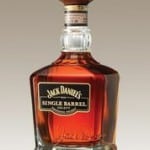
Brands Available in India:
Bourbon – Jim Beam, Maker’s Mark, Wild Turkey, Woodford Reserve, Medley’s, John Medley’s
Tennessee – Jack Daniel’s
How it’s drunk:
- Traditionally: Straight up or cocktails.
- Tastes best: If you are really looking at tasting the whiskey itself, it tastes best with a few drops of water or an ice cube.
- Contemporary: American whiskies is the most widely used style of whiskey when it comes to using them in cocktails. Apart from that Bourbon & Cola / ginger ale / soda are favourites throughout the world. Toby Cecchini a bar wizard par extraodrinaire was in India a few years ago, to evangelize on Bourbon cocktails, and we were fortunate enough to attend the session. Click here to read our account.
During the Prohibition era in the United States lasting from 1920 to 1933, all alcohol sales were banned in the country. The federal government made an exemption for whisky prescribed by a doctor and sold through licensed pharmacies. During this time, the Walgreens pharmacy chain grew from 20 retail stores to almost 400.
CANADIAN WHISKY
A Canadian Whisky is one which is produced and matured in Canada. Canadian whiskies are mainly products of a patent still and have a minimum of 49% of rye as the main grain in the grain blend. They are matured for a minimum of three years in new oak barrels. They are light and aromatic whiskies. The term ‘Rye whisky’ and ‘Canadian whisky’ can be used interchangeably due to extensive use of rye in the whisky making process.
Popular Brands: Canadian Club, Seagram’s, Black Velvet, Canadian Mist, Windsor Supreme, Crown Royal. Hard to find in India. Although you may find Canadian Club in duty free shops.
JAPANESE WHISKY
Although they started making whisky in 1870, the first commercial set up of Japan’s Whisky industry was done in the 1920’s when Shinjiro Torii started the first distillery in Japan. The Japanese are heavily influenced by the Scotch whisky making traditions and base their whiskies on them. The production process of Japanese whisky is similar to that of Scotch. Japan produces both blended whiskies as well as Single Malt whiskies which are mainly pot still products. The main grain used in making these is barley.
The Japanese include peating as a part of their whisky making process. Japan being an island, similar to Scotland, produces its own peat and at times imports peat from Scotland. This gives Japanese whiskies a smoky nature similar to that of Scotch, but they are not as heavily peated as the Scottish products.
Popular brands: Suntory, Nikka, Seagram’s Kirin, Sanraku Ocean, Yamakazi 12 YO Single Malt
Brands in India: Yamakazi, Hibiki
How it’s drunk: Japanese whiskies are served in the classical ‘Mizuwari’ way of drinking. The whisky is served with lots of ice and topped with water, with the ratio of whisky to water being 1:3 or 1:4.
Hiroyoshi (Mike) Miyamoto, the global brand ambassador for Suntory was visiting India a few years ago. Tulleeho had the opportunity to catch up with him, and we had a brief conversation, including discussing the pairing of Japanese Whisky with Indian food. To watch this video, click here.
INDIAN WHISKY
India’s whisky industry started in 1855 when the British set up the first distilleries in Solan, Himachal Pradesh. Later these distilleries were bought over by Indian businessmen, the most prominent person being Mr. NN Mohan of Mohan Meakins fame. India produces whiskies that are a blend of imported scotch malts and local grain whiskies. Some Indian whiskies are also made with a combination of local grains and molasses because of which they are not recognized as whisky, as defined by the European Union.
Popular brands: In India different brands have their own market in various parts of the country. Some of them are: Signature, Director’s Special, Royal Challenge, Director’s Special Black, Officer’s Choice, Imperial Blue, Royal Stag, Blender’s Pride, Mc Dowell No.1, Aristocrat Premium, Antiquity, Peter Scot, Royal Pride.
Brands exported: Amrut, Imperial Blue, Royal Stag, McDowells No.1, Real Choice
How it’s made: Apart from barley Indian whiskies extensively use molasses, in the whisky production. They are often blended with Grain spirits.
The Right Glass
- Glencairn Glass: It’s a style of glass developed by Glencairn of Scotland for drinking whisky. The shape of this glass is derived from nosing copitas which are widely used for the purpose of nosing and tasting whisky, mostly at a professional level. While there are numerous other glasses of similar kind, the Glencairn Glass is endorsed by The Scotch Whisky Association.
- The shape of this glass makes it a favourite amongst connoisseurs as the inward shape towards the top helps to hold the aromas.

- Other Glasses: The most popular of all the other glasses is a classic Old Fashioned glass. Apart from that Snifters and Nosing Copitas are popular choices for the discerning whisky drinker.


